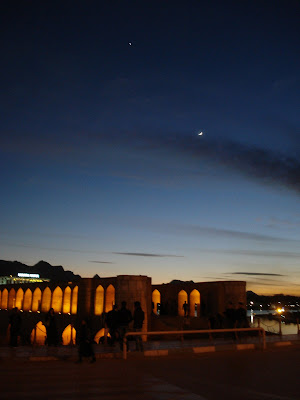The Southern Iwan of Esfahan’s Great Mosque
As Oleg Grabar has stressed many times in his book about Esfahan’s Masjed-e Jomeh, the mosque itself is perfectly embedded in the fabric of the Old City. There are no well-defined boundaries of the huge, 170 by 140 meters, complex. The main entrance is rather hidden at the eastern side of the building. Only helicopters and birds (or angels) may get an immediate impression of the huge dimensions of the mosques. I asked the officer near the ticket seller whether I was allowed to climb to the roofs. He declined, of course.
It was very early in the morning, the sun had just risen and the glazed tiles on the mosque’s façades were glowing like gold. It reminded me of the spectacular photos taken by Henri Stierlin. Pigeons were sitting on the South Dome and warming up in the sun. When entering the courtyard, the two domes of the mosque are not visible at first sight. In particular, the northern dome is not visible at all from here, one of the main reasons for having neglected this masterpiece of Islamic architecture during my previous visits. What attracts immediately the attention is the heavily decorated main iwan to the south. The two thin minaret-like towers have never been used for prayer calls.
The iwan contains inscriptions dated 1475-76 by the artist Sayyid Mahmud-e Naqash, who can be considered also responsible for certain decorations on the Darb-e Emam shrine only 300 meters to the west. While the latter was built during the reign of the Qara Qoyunly ruler Jahan Shah, the additions on the southern iwan of Masjed-e Jomeh were done during the time of Uzun Hassan, the great ruler of the Aq Qoyunly dynasty. Both show the highly decorative late Timurid style.
The numerous “elements of Shi’ite Muslim iconography of piety” point to the extensive embellishment during the Safavid era, in particular that of Shah Abbas II (1642-67).
See much more information here.

It was very early in the morning, the sun had just risen and the glazed tiles on the mosque’s façades were glowing like gold. It reminded me of the spectacular photos taken by Henri Stierlin. Pigeons were sitting on the South Dome and warming up in the sun. When entering the courtyard, the two domes of the mosque are not visible at first sight. In particular, the northern dome is not visible at all from here, one of the main reasons for having neglected this masterpiece of Islamic architecture during my previous visits. What attracts immediately the attention is the heavily decorated main iwan to the south. The two thin minaret-like towers have never been used for prayer calls.
The iwan contains inscriptions dated 1475-76 by the artist Sayyid Mahmud-e Naqash, who can be considered also responsible for certain decorations on the Darb-e Emam shrine only 300 meters to the west. While the latter was built during the reign of the Qara Qoyunly ruler Jahan Shah, the additions on the southern iwan of Masjed-e Jomeh were done during the time of Uzun Hassan, the great ruler of the Aq Qoyunly dynasty. Both show the highly decorative late Timurid style.
The numerous “elements of Shi’ite Muslim iconography of piety” point to the extensive embellishment during the Safavid era, in particular that of Shah Abbas II (1642-67).
See much more information here.
















Comments